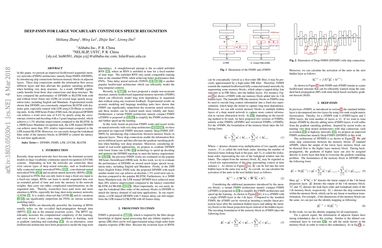Deep-FSMN for Large Vocabulary Continuous Speech Recognition
In this paper, we present an improved feedforward sequential memory networks (FSMN) architecture, namely Deep-FSMN (DFSMN), by introducing skip connections between memory blocks in adjacent layers. These skip connections enable the information flow across different layers and thus alleviate the gradient vanishing problem when building very deep structure. As a result, DFSMN significantly benefits from these skip connections and deep structure. We have compared the performance of DFSMN to BLSTM both with and without lower frame rate (LFR) on several large speech recognition tasks, including English and Mandarin. Experimental results shown that DFSMN can consistently outperform BLSTM with dramatic gain, especially trained with LFR using CD-Phone as modeling units. In the 2000 hours Fisher (FSH) task, the proposed DFSMN can achieve a word error rate of 9.4% by purely using the cross-entropy criterion and decoding with a 3-gram language model, which achieves a 1.5% absolute improvement compared to the BLSTM. In a 20000 hours Mandarin recognition task, the LFR trained DFSMN can achieve more than 20% relative improvement compared to the LFR trained BLSTM. Moreover, we can easily design the lookahead filter order of the memory blocks in DFSMN to control the latency for real-time applications.
PDF Abstract


